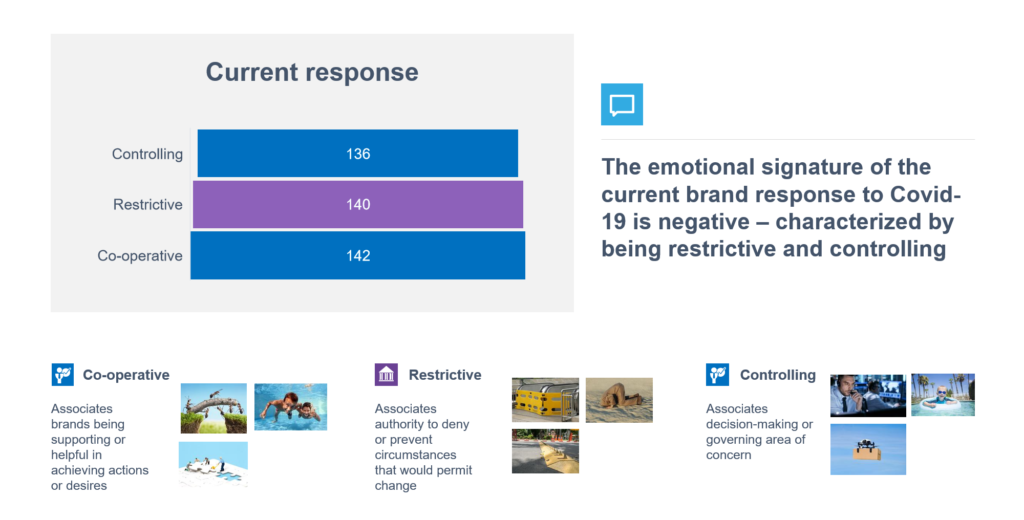Communicating With Emotions During the Coronavirus Pandemic
By Steve Brockway, Chief Research Officer | April 16, 2020
There’s no playbook for these unique times.
It’s created massive uncertainty for brands and business leaders as they look to navigate some truly unprecedented challenges.
It’s clear that brands and businesses still have a role to play in the weeks and months ahead. According to official UK government guidance, online retail is to be “encouraged”, even if it isn’t classed as essential.
Emotions are driving our daily decision-making more than ever; implicit results from our own COVID-19 Feel, Behave, Think tracker demonstrated that people’s excess household purchases were driven entirely out of fear and a loss of control. But failing to effectively understand these emotions poses a massive threat to the future of brands. It’s never been more important to understand effectively how people Feel, as well as how they Think and Behave.
Understanding emotions
Brand Emotion – Maru’s proprietary System 1 visual semiotics tool – uncovers the top emotional associations with brands, concepts or experiences. Results reveal not only the current emotional response to stimuli, but also what the ideal brand, concept or experience should feel like.
And we used it to understand the brand response to the Covid-19 Pandemic, measuring not just the impact of current communication but what the ideal response should be.
While consumers feel that brands are trying to co-operate, the overall emotional signature of how brands are responding is overwhelmingly negative and seen as ‘Restrictive’ and ‘Controlling’.
Control is an opposing emotion to co-operation. While the public-facing brand may be showing a co-operative spirit through its customer communications, it risks being deemed a façade, especially when messages lack true empathy, understanding and focus too much on products. In fact, ‘Empathy’ is one of the key emotional associations missing from the current brand response to the pandemic; if actions show you do not really understand how people are feeling then, at best, they will fail to connect with consumers and, at worst, damage brand perception and equity.
Brands are failing to connect with customers
Brands have taken on a more authoritative role. But unfortunately, consumers are projecting their personal feeling of quarantine restrictions and a loss of control onto brands: 40% of UK consumers outwardly state that they feel ‘frustrated’ by the current state of affairs.
Brands are controlling the supply and distribution of essential products and services like never before, and at the same time self-nominating themselves as ‘essential’.
There is a clear negative response to ‘non-essential’ companies continuing to trade in-person and putting workers at risk – rather than using their power and platform for good. At best this is seen as profiteering, and at worst a disregard for protection and safety of staff, the general public and the country.
Almost all (80%) of consumers agree that brands should be using their ‘platform to do good’. The bar has been set very high by consumers in how they expect brands to communicate and act. Whilst a brand themselves may be conveying the right emotions of co-operation through central advertising and comms any trace of disingenuous actions – whether with local store practices or internal communications – will automatically trigger negative emotions and associations to that brand.
How people want to emotionally connect with brands
Consumers are looking to brands to fill the emotional vacuum that this health crisis has created.
In times of need, consumers are looking for comfort, stability, co-operation and empathy. The ideal emotional response clearly demonstrates people are, above all, looking for a sense of comfort and reassurance during uncertain times (Content) and this is best delivered through a supportive approach (Co-operative) that shows you understand the issues individuals and collectives face (Empathy).
This is not the time to be advertising business as usual. There are, and will be, hero brands and villains post-pandemic.
It’s not about you, it’s about them
Brands must utilize brand equity spots that showcase the feel-good reasons why the brand is there for them, the consumer. Relationships must be the focus, not the product or the service.
The hero brand is communicating that “we are here for you now and will be in future”. Brands such as Virgin Media have understood public sentiment with their ‘Stay home, stay safe, stay connected’ campaign. EE are offering free data to customers, NHS staff and support to NHS trusts. We’ve also seen brand manufacturers such as Dyson take an early decision to pivot their operations switching to ventilators. Heinz has also pledged to provide 12 million children with free meals following the closure of schools with their ‘Breakfast isn’t going anywhere’ campaign. All these actions show an understanding of how people are feeling and look to use their platform to fulfill a wider purpose.
Consumers will build lasting bonds with brands that become a part of their lives during this time and demonstrate the right emotions of Contentedness, Co-operation and Empathy.
Crises build strong emotional bonds. Building equity now within the hearts and minds of consumers will pay dividends post-lockdown. The extent of that equity depends on how visible a brand is or how reliant consumers are to the brand.
Brands that continue down the path of the current approach, or fail to communicate at all, will come out the villain. Consumers will long have memories of brands that were disingenuous, restrictive and controlling during this crisis.
The time to engage and act is now.
To see how Maru/Matchbox is keeping a finger on the pulse of how businesses and consumers are managing in the pandemic, visit our COVID-19 research hub.


